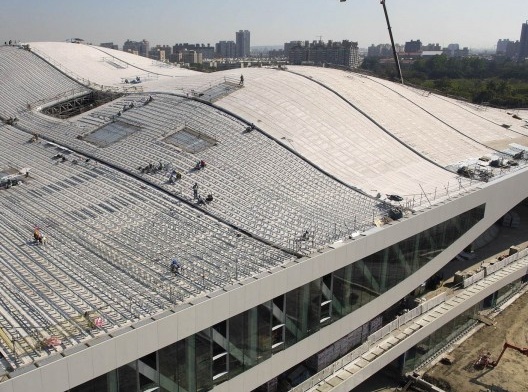
Wei Wu Ying Center for The Arts, Taiwan. Escritório Mecanoo
Foto divulgação [website Mecanoo]
Juarez Moara Santos Franco: The stiffeners in the panels avoid buckling. Is there a model for calculating the stresses and resistance in the panels? Is that made for the overall structure or panel by panel?
Peter Mehrtens: The stiffener or rib is produced with the first set of tools. They prevent buckling in the panel when the flat material is folded up into the [vertical] seam, that is creating the section. When there is a curve in the top view of a panel it means that the vertical seam is either being stressed or compressed. This brings in tension into the entire cross section. Having the ribs run parallel to the vertical seams (where the tension is being created) helps to relax this tension and then have the central part of the panel without tension. So the rib can compensate the tension of stretching and compressing the side vertical seams. We do use finite element analysis during the digital prototyping in project development. However, for any individual panel the algorithms are already pre-defined and we know the limits. So we do not need to have finite elements running for each section and we do have structural engineers in-house who take care of the overall issues. When you have a building envelope you have wind loads, you have the forces that need to be brought into the structure, what density of holders do you need, and what length of holders do you need to transport that, and these algorithms do use finite element technology.
JMSF: What if there is the need to replace one panel. Is that easy? How is it produced?
PM: You would remove the damaged panel by cutting it out and you need to substitute it by a new panel that can fit it. There are two options, either by lifting the second panel and putting in a new panel and reclosing it, or using a larger panel covering the seams on both sides. But if the machine is not there anymore, then this panel can only be produced where the machine currently is, and the panel must be shipped. For a single panel usually it is not likely that the machine is going to be taken to the place. It is basically a trade off. If it is a long panel, which is difficult to transport, it can be cut in parts for transportation and then re-weld on place. It is basically an economic decision. But it does not happen often. Standing seam metal roofing is a long-lasting [construction technology]. Sometimes the paint is damaged and then that part can be repainted and replaced.



